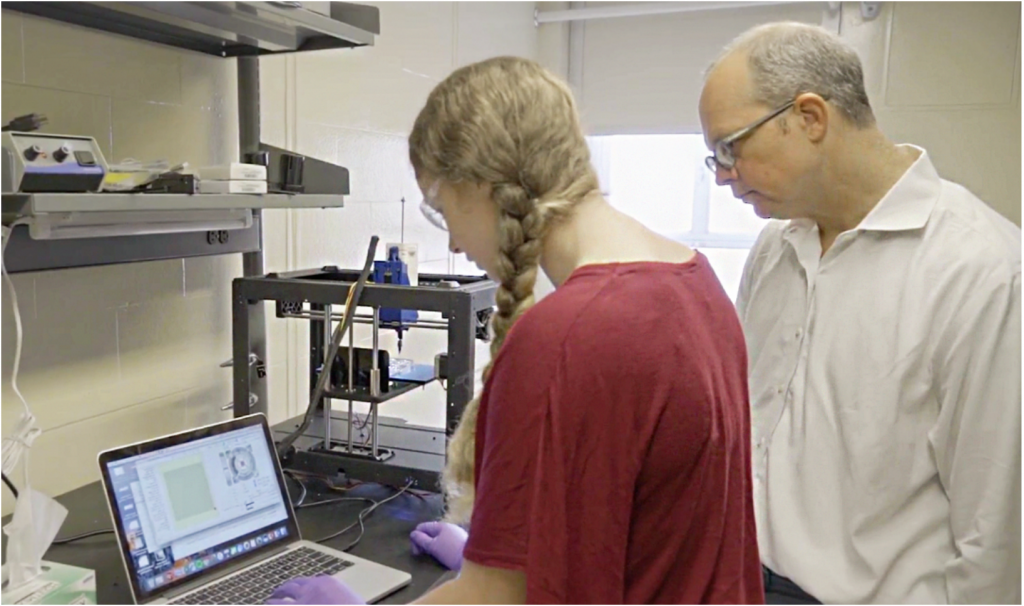Carnegie Mellon: Optimizing Soft Materials 3D Printing With Machine Learning
 While 3D printing soft materials, such as silicone or proteins, offers many advantages, it also introduces many new and complicated variables to consider when creating a new part. The existing soft materials that can be 3D printed commercially are somewhat limited since they don’t have all the properties that researchers need to fully advance their developments and they end up working within the constraints of the current technology.
While 3D printing soft materials, such as silicone or proteins, offers many advantages, it also introduces many new and complicated variables to consider when creating a new part. The existing soft materials that can be 3D printed commercially are somewhat limited since they don’t have all the properties that researchers need to fully advance their developments and they end up working within the constraints of the current technology.
One of the main problems with 3D printing a soft material is that it tends to deform under the forces that normally occur, sometimes even during the build, so they require support materials. According to researchers from the College of Engineering at Carnegie Mellon University, that means that additive manufacturing of soft materials requires optimization of printable inks, formulations of these feedstocks, and complex printing processes that must balance a large number of disparate but highly correlated variables (such as metal powder particle size, melt pool shape and size or filament feeding rate, extrusion width, linear plotting speed and layer thickness or suspension viscosity).
Due to the critical need for integrated methodologies, they have come up with a hierarchical machine learning (HML) algorithm that optimizes parameters of these type of materials for 3D printing, using Freeform Reversible Embedding (FRE)–a recently developed method for 3D printing of liquid polymer precursors that involves controlled deposition of a fluid precursor into a supporting aqueous bath.
Newell Washburn, professor of biomedical engineering and chemistry at Carnegie, leads the team, made up of colleagues Adam Feinberg, associate professor of biomedical engineering and materials science and engineering; Barnabas Poczos, professor of machine learning at the School of Computer Science; and materials science and engineering doctoral student Aditya Menon. They recently published a paper on their work, titled “Optimization of Silicone 3D Printing with Hierarchical Machine Learning“, in 3D Printing and Additive Manufacturing. The paper demonstrates how their new algorithm was designed to optimize high quality, soft material 3D prints.
“Increasingly, we’re starting to make more soft material-based components and devices for low-tech areas such as sensors and medical applications, and for high tech areas like soft robotics,” said Washburn. “But every time you add another component you exponentially raise the complexity of the manufacturing process. That’s where a machine learning algorithm could really help with optimization.”
Machine learning algorithms, which are a type of artificial intelligence algorithm, are designed to develop a relationship between the input variables and the outputs of a complex system based on training data. According to Carnegie Mellon, traditional algorithms in machine learning tools generally treat systems as black boxes and then attempt to define a response surface based on statistical analysis. This then requires extensive data sets to train these models, which can be difficult to generate, especially given the number of variables and time required to probe experimental processing parameters. But for the complex problem that the research team is working on, there isn’t a lot of data. Therefore, to account for this, Washburn and his team custom-built an HML algorithm that incorporates expert knowledge about how the physical systems and parameters operate with limited data available. Washburn assures that HML uses knowledge of the underlying physical system—in this case, the physics of the FRE 3D printing variables—to draw connections between the right variables, significantly cutting time and the amount of data needed.
“This new machine-learning algorithm is a powerful tool that we have designed to use in our research work for complex physical systems, it uses very small data sets allowing us to optimize their performance. For the 3D printing projects, the material and the technologies we are developing will allow us to optimize the 3D printing of entire organs where we are applying a complex mixture of components, materials, and cells. The overall goal of our research is to design materials for function and not just composition, leveraging the understanding of how these materials work,” Washburn claims.
The researchers were able to print 2.5 times faster, print with ink that previously didn’t work well, and the algorithm also identified a unique silicone formulation and printing parameters that had not been found previously through trial-and-error approaches. With these results, the researchers—some of whom are affiliated with both the Manufacturing Futures Initiative and the Bioengineered Organs Initiative—are optimistic that HML will have a broad application for planning and optimizing in the AM of many types of soft materials, such as for biomedical applications via the FRE method.
The team used a Makerbot Replicator printer custom modified with a syringe pump extruder to perform all of the 3D printing tests and used silicone elastomers from Dow Corning as materials
In 2018, another team of researchers at Carnegie Mellon’s College of Engineering came up with a novel approach to optimize soft material 3D printing: an expert-guided optimization (EGO) method that also uses the FRE 3D printing method. The EGO model is based on an algorithm to optimize the process, but it also depends upon the researcher’s evaluation and parameters. While Washburn’s algorithm responsibly selects the optimal parameters for the variables in different categories, accelerating the process.
“Essentially what we’re doing is building a digital twin, or a digital replica, of both the physical process and our human conceptual understanding of the process to achieve optimal results,” asserted Washburn.
According to the paper, HML is applied to 3D printing of silicone elastomer via FRE, which was challenging because it involves depositing a Newtonian prepolymer liquid phase within a Bingham plastic support bath. It also details that the advantage of the HML algorithm is that it can predict the behavior of complex physical systems using sparse data sets through the integration of physical modeling in a framework of statistical learning. Showing that the algorithm can be used to simultaneously optimize material, formulation, and processing variables.
 Last year, Washburn and Poczos started the company Ansatz AI, to commercialize the algorithm and are currently working with their first customer in industrial applications, which means we should be able to see some results in 2020. Washburn is co-founder and the managing member of the company which uses the HML algorithm developed at Carnegie Mellon to model and optimize complex physical systems, ranging from cosmetics and personal care products to paint and cement, and even production systems.
Last year, Washburn and Poczos started the company Ansatz AI, to commercialize the algorithm and are currently working with their first customer in industrial applications, which means we should be able to see some results in 2020. Washburn is co-founder and the managing member of the company which uses the HML algorithm developed at Carnegie Mellon to model and optimize complex physical systems, ranging from cosmetics and personal care products to paint and cement, and even production systems.
As stated by the company: “HML leverages domain knowledge of these systems in the form of physical models but uses powerful tools of statistical learning to uncover the hidden connections between variables”.
Ansatz AI will focus on working with manufacturers of chemical and materials based products across many industries.
Working to solve some of the basic problems of AM and materials is not new to Carnegie Mellon, the renown university (which ranks fourth out of the top engineering schools in the US) was also recently in the news when a team of researchers published a paper after they bioprinted hearts comprised of small cardiac ventricles using human cardiomyocytes, thanks to an advanced version of Freeform Reversible Embedding of Suspended Hydrogels (FRESH) technology–which allows them to 3D print collagen. Professors of biomedical engineering at the university have been working to improve the functionality of soft materials for a few years, and the university itself has immersive 3D printing experiences for students and professors in a diversity of areas, efficiently demonstrating that they will be part of the advances in this disruptive technology.
[Images: Carnegie Mellon and Newell Washburn]Subscribe to Our Email Newsletter
Stay up-to-date on all the latest news from the 3D printing industry and receive information and offers from third party vendors.
Print Services
You May Also Like
3D Printing Grows to $15.9B in 2024 Amid Shifting Industry Dynamics
The global additive manufacturing (AM) market reached $15.9 billion in calendar year 2024, according to “Q4 2024 3DP/AM Market Data and Forecast” from Additive Manufacturing Research (AM Research). Despite a...
3DPOD 247: LJ Holmes, Executive Director for the Center of Advanced Manufacturing and Materials at Harrisburg University
Executive Director for the Center of Advanced Manufacturing and Materials at Harrisburg University, Larry “LJ” Holmes is a pioneer in applying additive manufacturing to defense and other critical sectors. Part...
Thai Startup OsseoLabs to Cut Surgery Time with 3D Printed Magnesium Implants
A patient undergoing mandibular reconstructive surgery typically faces two separate operations: one to place a custom-fit titanium plate and another month later to remove it. But what if that second...
Japanese Advanced Manufacturing Capabilities Grow in Europe with Sodick’s Purchase of Prima Additive
The global economy is currently undergoing a reshuffling in terms of what gets manufactured where. In large part, this trend is being driven by new geopolitical alliances and the need...




























